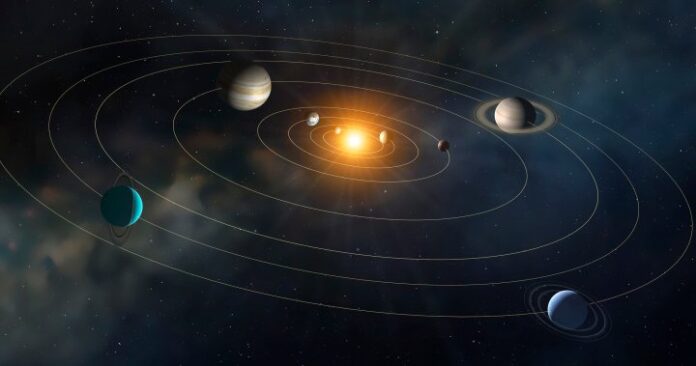For years, astronomers have been searching for a ninth planet in our solar system (after giving Pluto the old heave-ho and demoting it to a dwarf planet) and now researchers say they’ve found a promising candidate.
The long-theorized Planet 9, which astronomers have speculated could be a Neptune-sized planet that has been lurking on the outer edge of the solar system, could explain the unusual clustering and movements of distant objects in the Kuiper Belt beyond Neptune, but tracking such a mass has largely been unfruitful.
Now, a newly identified object spotted in two infrared sky surveys has renewed the question of whether the elusive and hypothetical Planet 9 actually exists.
According to a new pre-print study, shared in late April and approved for publication in the journal Publications of the Astronomical Society of Australia — but has not yet been peer-reviewed — researchers found a curious dot on infrared images taken 23 years apart that seems to be moving in a manner consistent with a large, distant planet.
“I felt very excited,” study lead author Terry Phan, an astronomy doctoral student at the National Tsing Hua University in Taiwan, told Science about his team’s discovery. “It’s motivated us a lot.”
As with all Planet 9 research, the findings have been met with skepticism — even the study’s researchers acknowledge that the surveys have not provided enough data to determine the full orbit of a planetary candidate and that more observations will be needed.

Astronomer Mike Brown, who was first to propose the Planet 9 hypothesis in 2016 alongside colleague Konstantin Batygin, told Science that it’s going to take more evidence that the infrared dots observed in the latest study correspond to a ninth planet.

Get daily National news
Get the day’s top news, political, economic, and current affairs headlines, delivered to your inbox once a day.
He told the publication that, by his own calculations, the candidate signal’s orbit would be tilted roughly 120 degrees from the plane of the solar system, meaning it would actually orbit the Sun in the opposite direction than the other eight planets. According to his models, to explain the clustering and movement of other objects in the Kuiper belt, Planet 9 would need an orbit tilted roughly 15 to 10 degrees from the plane of the solar system.
This mismatch “doesn’t mean it’s not there, but it means it’s not Planet 9,” Brown said. “I don’t think this planet would have any of the effects on the solar system that we think we’re seeing.”
Brown’s discovery of Eris, an icy world in the Kuiper Belt beyond Pluto, led to the reclassification of Pluto as a dwarf planet. He has been dubbed the “Pluto Killer.”
In 2016, he expressed his excitement about a possible replacement planet for the one he killed off.
“All those people who are mad that Pluto is no longer a planet can be thrilled to know that there is a real planet out there still to be found,” Brown said at the time. “Now we can go and find this planet and make the solar system have nine planets once again.”
In a NASA post, titled “Is Planet X real?”, the space agency lays out the research done by Brown and Batygin, summarizing how Planet 9 would behave and appear, if proven real.
“This hypothetical Neptune-sized planet would circle our Sun on a highly elongated path, far beyond Pluto. It could have a mass about 5 to 10 times that of Earth and orbit about 20 to 30 times farther from the Sun on average than Neptune. It would take between 10,000 and 20,000 Earth years to make one full orbit around the Sun,” the agency writes, adding that there are several lines of observational evidence pointing to the existence of a ninth planet.
While Planet 9’s existence remains fully up in the air, more evidence could become available within a year or two, when a Chilean observatory that’s currently under construction opens, giving a better glimpse into what lies at the edge of our solar system.
The Vera C. Rubin Observatory will use the world’s largest digital camera to peer deeper into space than any predecessor.
Earlier this year, Brown told NPR that there’s no better telescope to help prove, or disprove, the existence of Planet 9.
“If you were to hand me a big wad of cash and say, ‘Go build a telescope to go either find this Planet 9 or find the best evidence possible for Planet 9,’ I would probably go and build the Vera Rubin Observatory,” Brown said. “It really is a telescope that is perfectly suited for making the next step.”
Even if they aren’t able to actually observe a new planet, he added, the Rubin observatory should give astronomers enough new data to prove whether his hypothesis and observed patterns of objects in the Kuiper belt hold up.
“I think that what Vera Rubin will definitively do,” says Brown, “is tell us whether we’re crazy or not.”
© 2025 Global News, a division of Corus Entertainment Inc.





